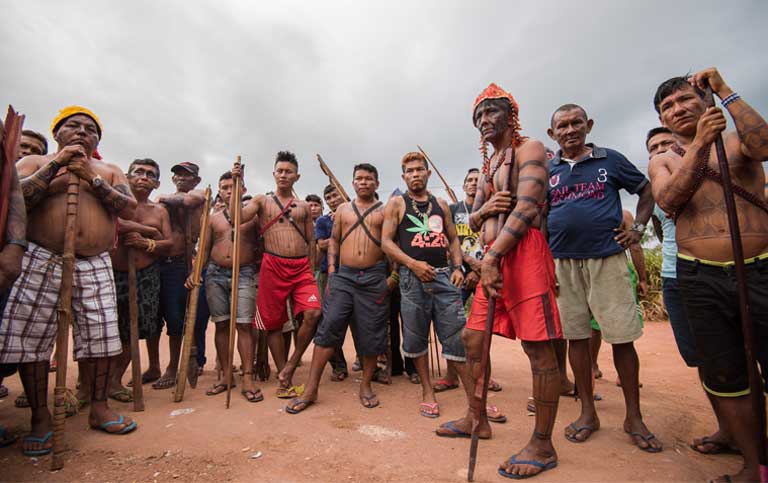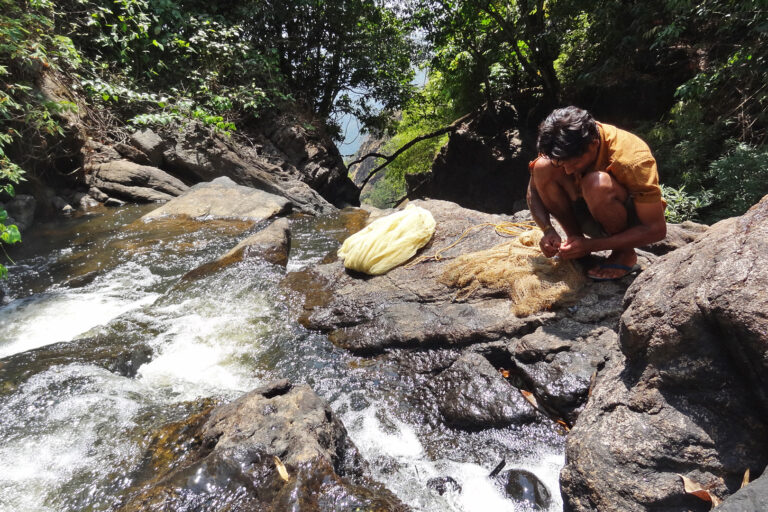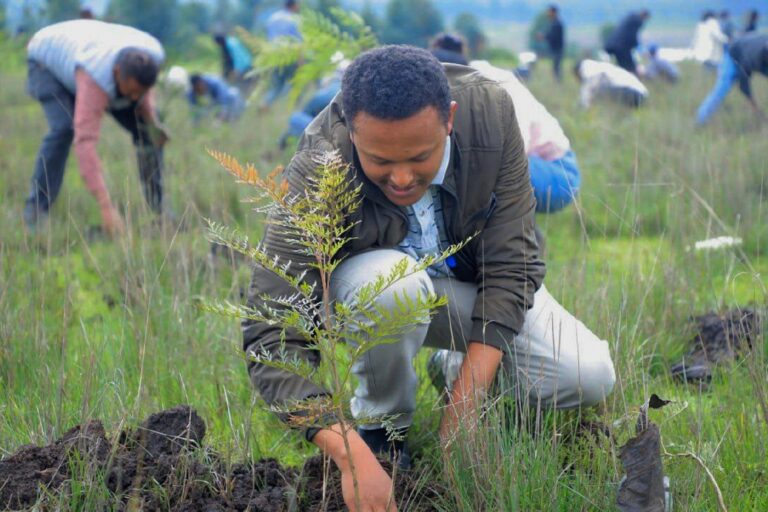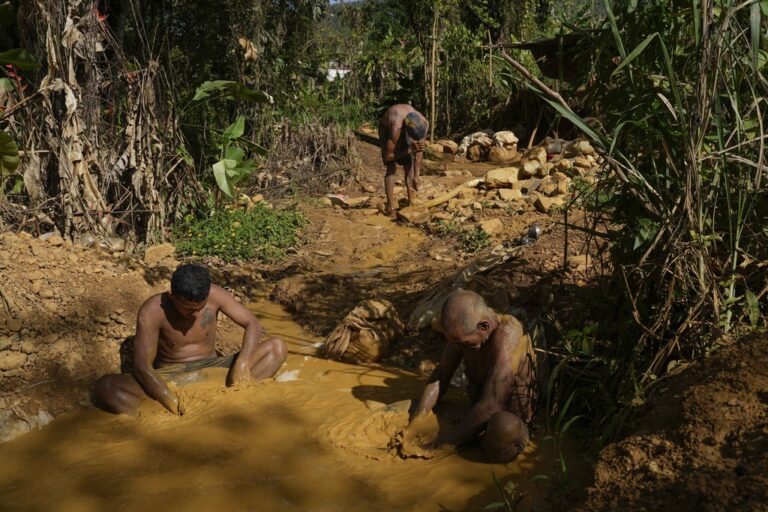- Indigenous groups control large reserves in the Amazon and have the constitutional right to more, but agribusiness and land thieves are working with the Brazilian Congress and the Temer administration to prevent recognition of new indigenous territories, and to defund FUNAI, the federal agency representing Indian concerns.
- In response, Brazil’s Indians are launching numerous protests. Last week more than 4,000 indigenous leaders from 200 tribes gathered in Brasilia to demonstrate. They were greeted in front of the Congress building with a police teargas attack.
- Emboldened by government support, ranchers and their hired gunmen brutally attacked a peaceful land occupation by members of the Gamela tribe in Maranhão state in northern Brazil on 30 April with rifles and machetes; 13 Indians were seriously injured.
- In the Amazon, the Munduruku have blocked the Transamazonian highway, creating a 40 kilometer backup of trucks loaded with the soy harvest. In an unusual twist, the truckers met with the Munduruku Wednesday afternoon and expressed solidarity with the Indians, agreeing that the government’s failure to meet the people’s needs is the real problem.


(Leia essa matéria em português no The Intercept Brasil. You can also read this article in Portuguese at The Intercept Brasil)
Indigenous groups are making a defiant stand against the current wave of fiercely anti-Indian policies being rapidly implemented by Brazil’s Temer administration and Congress.
Protests blossomed last week in Brasilia where a four-day demonstration — the largest in the nation’s history — brought together over 4,000 indigenous leaders from more than 200 tribes seeking government redress of grievances. The protesters were met with teargas.
Likewise, a peaceful land occupation by members of the Gamela tribe in Maranhão state ended in violence when their camp was raided by ranchers and hired gunmen who beat the Indians brutally, even hacking off hands with machetes.
In the Amazon, members of the Munduruku tribe, armed with bows and arrows, set up a roadblock on the Transamazonian highway, creating a 40 kilometer (25 mile) backup of trucks loaded with this year’s soy harvest.
The blockade came in protest of the government’s refusal to demarcate the Indians’ lands as assured under the 1988 Brazilian Constitution. The commodities roadblock also sent a clear signal to the bancada ruralista, Brazil’s agribusiness lobby, which dominates Congress and the administration, and which pushed for the dramatic upsurge in federal initiatives rolling back indigenous land rights and protections.
A glimpse of the traffic backup at the Munduruku blockade. Video by Mauricio Torres
Violence in Maranhão
On 30 April gunmen and ranchers attacked an indigenous camp in Maranhão, an impoverished state in northeast Brazil, long dominated by powerful landowners led by the Sarney family (one of whom is Pres. Temer’s environment minister, José Sarney Filho).
The violence was triggered by events two days earlier, when several dozen Gamela Indians occupied disputed land near the town of Viana, 214 kilometers (133 miles) from the state capital of São Luis.
This land was traditionally occupied by the Gamela, but the military dictatorship (1964-1985) illegally ejected them from it. Ranchers then occupied the area, clearing the forest, planting pasture and raising cattle. As years passed, the ranchers began to see themselves as the legitimate owners.
About 300 Gamela families remained in the region, however, determined to regain their land despite the slight odds of doing so. Regardless of the legitimacy of their claim, the Indians received little help from authorities, with the federal Indian agency FUNAI, under pressure from the ranchers, refusing to begin the process of marking out the boundaries of the Gamela territory.
Three years ago the Indians went to court to force the ranchers to relinquish the land, but the case was stalled by bureaucratic delays. With their living conditions worsening year-by-year, the Gamela became convinced that they would only survive as a people if they took action. So they began a series of retomadas or re-occupations of their traditional land.
They timed the latest reoccupation to coincide with both the indigenous protest in Brasilia and a national one-day general strike, the first in 21 years, organized by Brazil’s trade unions in protest over the Temer government’s severe austerity measures.

It was a risky strategy, particularly in view of the strong anti-indigenous sentiment in Brasilia, and the local ranchers responded rapidly. According to one report, they sent out a WhatsApp message, calling on ranchers and their gunmen to gather near the indigenous camp.
Messages supporting the ranchers flooded the media. Federal deputy, Aluisio Guimarães Mendes Filho, (the state’s Public Security Secretary during the government of Roseana Sarney, another member of the Sarney clan), spoke out in a local radio interview, accusing the Gamela of being “troublemakers” and encouraging violence against them.
“He fanned the flames,” said one Indian later.
The ranchers had a barbecue, drank a lot of alcohol, and became increasingly abusive in their talk about the Indians. It was clear that an attack was being planned, but when it happened, the military police (who had arrived on site earlier) didn’t intervene.
The Indians were vastly out-numbered and could do little but flee into the forest when attacked by men wielding rifles and machetes.
According to Cimi (the Catholic Missionary Council), 13 Indians were injured. Two had both hands lopped off. Others were severely beaten; one had a fractured skull. One of the injured is Kum ‘Tum Gamela, a former priest, who has received numerous death threats in the past.
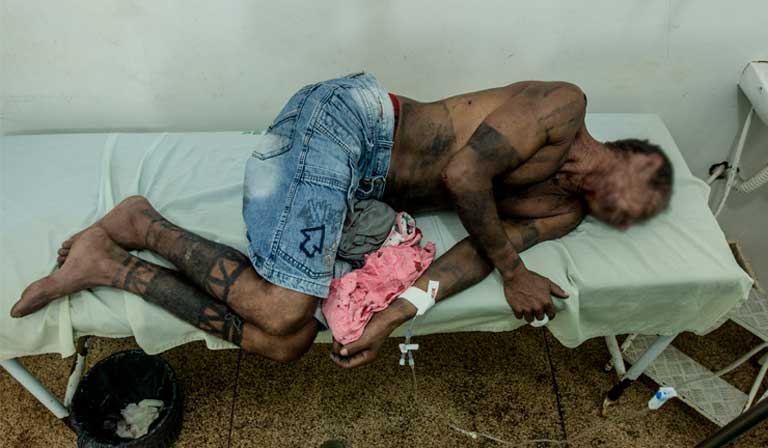
The Ministry of Justice issued a press statement in which it promised to investigate “the incident that involved small farmers and supposed Indians in the hamlet of Bahias.” The term “supposed” generated a wave of indigenous anger and was quickly deleted from the statement. Later the term “small farmers” was also removed, as it was widely criticized as being a euphemism for the gunmen employed by the ranchers. In the end, the statement merely said that that the ministry would investigate a “rural conflict.”
The Human Rights Commission of the prestigious Brazilian Bar Association (OAB) is to request help from the human rights body, Amnesty International, to resolve the dispute.
Munduruku roadblock
Another serious conflict is still underway, though it has not, as yet, resulted in violence. On 28 April, 130 Munduruku Indians and members of the Tapajós riverside communities of Montanha and Mongabal blockaded the Transamazonian highway, occupying a bridge about 25 kilometers (15 miles) east of the new port of Miritituba, a key transhipment point for the soy industry, where international trading giants, such as Bunge and ADM, have large terminals.
With the soy harvest in full swing, the road soon became highly congested, with at least a 40 kilometer (25 mile) backup of large trucks, carrying soybeans to Miritituba. The blockade was lifted during the night from 28 April forward, but was then re-imposed as a 24-hour blockade on the morning of 3 May.
A Mongabay contributor was accidentally caught up in the traffic, and on arriving at the road block he stayed to cover the showdown.

Antonio Munduruku, a young Indian, told Mongabay two reasons why the blockade was imposed: “We want the FUNAI employees who were working with us to be reinstated. We need them. They are our greatest tool in getting our lands marked out. And we won’t leave with empty hands. The FUNAI president told us on Friday that he’d sorted it out. But we don’t believe in words any more. We want their reinstatement published in the official gazette.”
He went on: “The second reason is to get the Sawré Muybu indigenous territory properly marked out. It’s our land but nothing is happening. Loggers are carrying on extracting timber.”
Vicente Saw, an old cacique, leader, said that stopping traffic on highways was effective: “The heart of the government is here on the road,” he said.

The will to resist
The Munduruku were shocked but not surprised by what happened to the Gamela: “They’re a different ethnic group but they are our brothers, with the same blood,” said Jairo Saw Munduruku. “We mustn’t let what’s happened to them happen to us. The government must mark out our land. If not, big loggers, big mining companies, will come in. And they will start conflicts, attacking us, assassinating leaders. That’s what the government wants but we must stop it happening. We don’t have anyone speaking for us in Congress. We have to defend ourselves.” Attempts by Mongabay to reach the Brazilian government for comment in recent weeks have been met with no response.
The Munduruku feel no hostility toward the truck drivers. An old indigenous leader, Tomas Munduruku, said: “We’re in favor of the truck drivers. They need our support too. It’s not right that the government is cutting their pensions.”
More surprisingly perhaps, many of the truck drivers are supportive of the Indians too. Trucker Mario de Nascimento said: “This road is essential for Brazil and the protest must stop. But the Indians’ rights aren’t being respected, just like ours aren’t being respected. But we are carrying Brazil on our backs. We can’t stop. We need the government to sort it out. None of us deserves the way we’re being treated.”
Another trucker, who didn’t want to give his name, said: “They [the Indians] are right. You can’t deny that. And if some of the people here want to lynch me for saying that, then let them lynch me.”

Time and again, the truckers, like the Indians, blamed the government for failing to listen, declaring flatly: “The biggest problem is the government.”
The concern is that the Amazonian heat, hunger and thirst will affect both Indians and truck drivers, and that tempers may begin to fray. One truck driver, who also didn’t give his name, threatened: “We’re going to drive our trucks over the Indians, pushing them all over, Indian after Indian. If our dreadful federal government doesn’t manage to get the blockade lifted soon, that’s what we’ll do.”
Another trucker said, in exasperated jest: “It’s getting terrible for all of us. I haven’t had a shower for more than 24 hours, in this heat. I feel like throwing my underpants into the river. They’d kill the fish. So the Indians wouldn’t have fish to eat, nor any of us have fish either.”
With the drivers stretched over many miles, it’s difficult to assess the truckers’ overall mood, but there was a surprising development Wednesday afternoon. A substantial group of truckers and Indians held a meeting beside the highway, during which both sides expressed support for the other’s struggle, saying that their chief complaint is against the current government.
Although not all truckers share this opinion, a significant number do. That is an extraordinary new development because, in the past, Indian actions of this type caused huge resentment among affected parties, particularly truck drivers. It is indicative of the very high level of rejection in Brazil of the ruling government by voters of all kinds, with Pres. Temer’s support now standing at an unprecedented low of 9 percent.

Growing dissent
Protests in Maranhão and Pará are not isolated cases. All over Brazil Indians are expressing grave fears about the future. Paulo Marubo, an Indian from the Javari Valley in the state of Amazonas, not far from the border with Peru, says that FUNAI, decimated by budget cuts, will have to close many of its offices for ethno-environmental protection (Bapes), which play a key role in monitoring the territory occupied by uncontacted tribes.
Marubo told Survival International: “If the protection teams are withdrawn, it will be like before, when many Indians were massacred and died as a result of disease… If the loggers come here, they will want to contact the uncontacted, they will spread diseases and even kill them.”
Instead, the federal government seems to be turning its back on indigenous demands. During his first 55 days in office, justice minister Osmar Serraglio didn’t have a single meeting with an Indian but found time to sit down behind closed doors with a 100 landowners plus businessmen accused of corruption in the Car-Wash scandal.
During the large protest in Brasilia, Serraglio and Eliseu Padilha, Temer’s chief-of-staff, belatedly offered to meet the Indians, but that offer was turned down. The two officials are known to have drawn up the government’s anti-indigenous strategy and, with no offer of compromise on the table, the indigenous leaders saw little point in meeting with them.
The current assault on indigenous rights is the most severe since the end of the military dictatorship in 1985. The NGO ISA (Socioenvironmental Institute) says there has been an “exponential increase in rural violence” since Temer took over. It comments: “The fact that the ministry of justice is occupied by [Osmar Serraglio], an advocate of injustice reinforces the sinister omens of what lies ahead.”
(Leia essa matéria em português no The Intercept Brasil. You can also read this article in Portuguese at The Intercept Brasil)
FEEDBACK: Use this form to send a message to the author of this post. If you want to post a public comment, you can do that at the bottom of the page.
